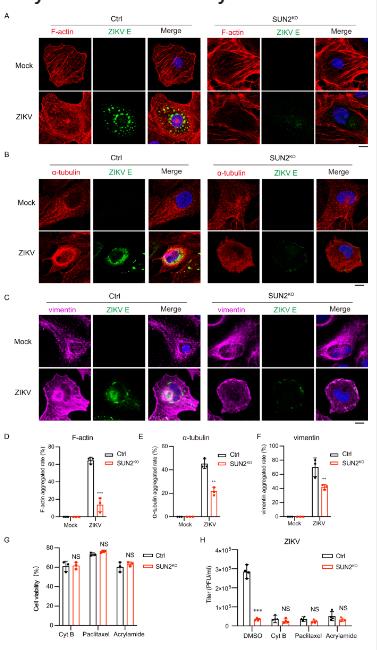Yellow viruses, including dengue virus (DENV), Zika virus (ZIKV), and Japanese encephalitis virus (JEV), are mostly transmitted through mosquito vectors and are currently one of the most widespread and highly infected infectious diseases, posing a huge threat to global public health. The infection of the yellow virus not only causes mild and self-limiting diseases (such as dengue fever and dengue hemorrhagic fever), but is also closely related to neurological diseases (such as neonatal microcephaly, encephalitis, Guillain-Barre syndrome, etc.). However, there are currently no targeted drugs in clinical practice.
Yellow virus is a single-stranded RNA virus that can only encode ten viral proteins and must recruit and carry host proteins to complete its lifecycle. Identifying and elucidating host proteins involved in virus replication can provide new targets for screening antiviral drugs. Professor Zhang Ping’s team from Sun Yat-sen University’s Sun Yat-sen School of Medicine published a paper titled “Nuclear membrane protein SUN2 promotes replication of flaviviruses through modulating cytoskeleton reorganization mediated by NS1″ in Nature Communications. This study reveals that although the yellow virus completes its replication cycle in the cytoplasm, it requires the involvement of cell nuclear membrane proteins.
Our Featured Products
Cat. No. |
Product Name |
Source |
Species |
Tag |
| SUN2-16241M | Recombinant Mouse SUN2 Protein | Mammalian Cell | Mouse | His |
| SUN2-3017H | Recombinant Human SUN2 Protein, MYC/DDK-tagged | HEK293 | Human | Myc/DDK |
| Sun2-6841M | Recombinant Mouse Sun2 Protein, Myc/DDK-tagged | HEK293T | Mouse | Myc/DDK |
| RFL29314MF | Recombinant Full Length Mouse Sun Domain-Containing Protein 2(Sun2) Protein, His-Tagged | E.coli | Mouse | His |
| NS1-857D | Recombinant Dengue virus NS1 protein, His-tagged | HEK293 | Dengue | His |
| NS1-589D | Recombinant Dengue Virus Subtype 4 NS1 protein | Insect Cell | Dengue | N/A |
| NS1-590D | Recombinant Dengue Virus Subtype 3 NS1 protein | Insect Cell | Dengue | N/A |
| NS1-591D | Recombinant Dengue Virus Subtype 2 NS1 protein, His-tagged | Insect Cell | Dengue | His |
| ACTN1-9339H | Recombinant Human ACTN1, GST-tagged | E.coli | Human | GST |
| ACTN1-45H | Recombinant Human ACTN1 protein, His-tagged | E.coli | Human | His |
| ACTN1-486R | Recombinant Rat ACTN1 Protein | Mammalian Cell | Rat | His |
| ACTN1-228H | Recombinant Human ACTN1 Protein, GST-tagged | Wheat Germ | Human | GST |
The researchers first found that knocking out the nuclear membrane protein SUN2 resulted in a significant decrease in replication levels among multiple members of the yellow virus, including ZIKV, DENV2, and JEV. It is interesting that the absence of SUN1, a homologous protein of SUN2, does not affect the replication of these viruses. How do proteins located on the nuclear membrane regulate viral replication in the cytoplasm? Researchers found through replicon experiments and transmission electron microscopy that SUN2 mainly regulates the replication of genomic RNA in yellow viruses, and observed that SUN2 is involved in virus-induced endoplasmic reticulum membrane remodeling and the formation of replication vesicles. As an important site for the replication of yellow virus RNA, viral replication vesicles are formed by the non-structural proteins of the virus jointly driving the reconstruction of the cytoskeleton and endoplasmic reticulum membrane. So, how does SUN2 regulate the formation of replication vesicles? Researchers have found that after SUN2 knockout, the binding of the virus’s non-structural protein NS1 to the cytoskeletal protein actin significantly decreases and weakens actin remodeling, suggesting that SUN2 is a key protein mediating NS1/actin binding, endoplasmic reticulum, and cytoskeletal remodeling.

SUN2 is located on the intracellular nuclear membrane, how does it “remotely” control the movement of the cytoplasmic cytoskeleton? Researchers speculate that SUN2 may transmit mechanical forces through the outer nuclear membrane proteins Nesprings connected to it, guiding the movement of the cytoplasmic skeleton. The immunoprecipitation experiment showed that SUN2, Nesprint, actin, and NS1 did indeed interact with each other. After viral infection, the outer nuclear membrane protein Nesprings aggregates towards the nucleus in a SUN2-dependent manner. When the structural integrity of Nesprings is disrupted, the interaction between NS1 and actin weakens, indicating that SUN2 and Nesprings jointly mediate the formation of replication vesicles induced by NS1 actin. In addition, the negative dominant expression of Nesprings, like SUN2 knockout, significantly downregulates the replication level of the virus.
Finally, researchers used a mouse model infected with the virus to confirm that SUN2 knockout significantly reduces the replication, transmission, and pathogenicity of Zika virus in animals. In summary, this paper elucidates that the mechanism by which nuclear membrane protein SUN2 promotes viral activity is that SUN2 works together with Nesprings to promote NS1-actin-induced cytoskeleton remodeling and replication vesicle formation, regulating the synthesis of yellow virus RNA. This also suggests that in addition to the cytoskeleton, other proteins in the cytoskeleton system, such as nuclear membrane proteins SUN2 and Nesprings, are also key factors in the replication of yellow viruses.
Related Services
Protein Expression and Purification Services
Reference
Huang, Y., Peng, Q., Tian, X., Chen, C., Zhu, X., Huang, C., Huo, Z., Liu, Y., Yang, C., Liu, C., & Zhang, P. (2024). Nuclear membrane protein SUN2 promotes replication of flaviviruses through modulating cytoskeleton reorganization mediated by NS1. Nature Communications, 15(1), 1-18. https://doi.org/10.1038/s41467-023-44580-6